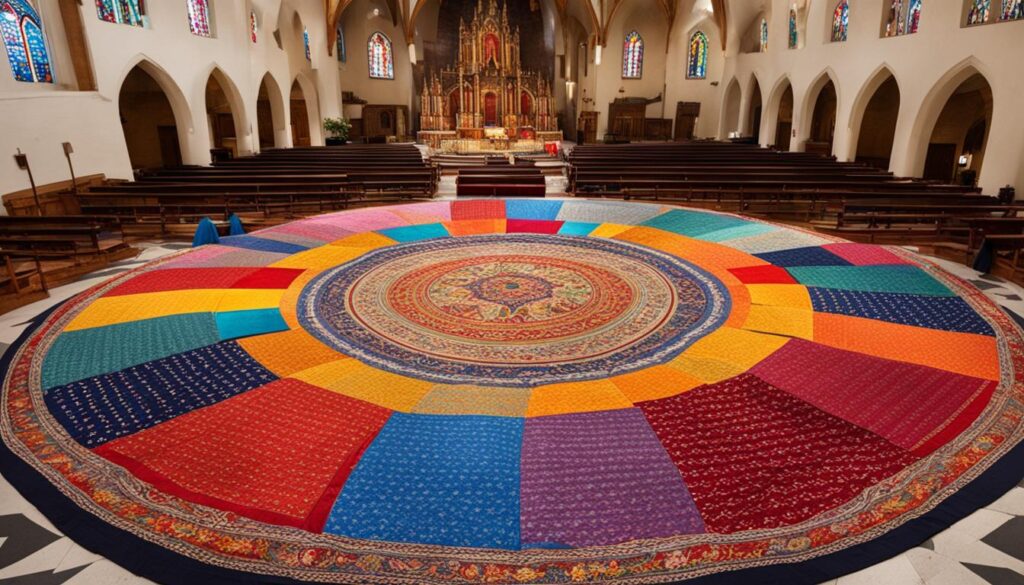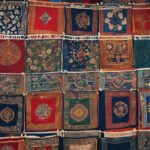A prayer cloth is recognized as a sacramental in certain church traditions and is popular among Pentecostal Christians in particular. While the words “prayer cloth” are not found in the Bible, there are instances where pieces of clothing are used in acts of divine healing power.
Key Takeaways:
- Prayer cloths are not specifically mentioned in the Bible, but there are biblical accounts of using cloth for healing.
- Pentecostal Christians and Methodists are among the denominations that use prayer cloths in their traditions.
- Prayer cloths serve as a visible reminder of God’s healing power and can be a way for believers to participate in praying for someone’s healing.
- The Bible emphasizes the importance of seeking prayer from the church community and relying on the prayers of righteous individuals, rather than attributing healing to specific objects like prayer cloths.
- While prayer cloths can symbolize care and connection with God, their efficacy relies on God’s will rather than the cloth itself.
The Use of Prayer Cloths in Christian Traditions
Prayer cloths hold a significant place in various Christian traditions, particularly in the Pentecostal and Methodist denominations. These cloths are used as tangible symbols of faith and are believed to facilitate divine healing. While the term “prayer cloth” is not explicitly mentioned in the Bible, its usage can be traced back to biblical references of using clothing for acts of healing.
In the Pentecostal tradition, prayer cloths are commonly employed in the context of prayer for the sick. They are either applied to the individuals during church services or taken to the homes of those in need of healing. This practice reflects the belief that the cloth becomes anointed through prayer and serves as a point of contact for God’s healing power.
Similarly, Methodists also embrace the use of prayer cloths. These cloths are often anointed with oil and used for prayer and healing purposes. While the specifics of their usage may vary across different denominations and congregations, the underlying belief in the efficacy of prayer cloths remains consistent.
Table 2: Comparison of Prayer Cloth Usage in Pentecostal and Methodist Traditions
| Pentecostal Tradition | Methodist Tradition |
|---|---|
| Prayer cloths used for healing in church and home settings | Anointing of prayer cloths with oil for healing purposes |
| Belief in the anointing and divine power of the cloth | Similar emphasis on the sacredness and efficacy of the cloth |
| Often distributed and shared among believers | Prayer cloths may be given to individuals in need or used in congregational prayers |
| Symbolic representation of faith and God’s healing presence | Symbolizes the connection between prayer, faith, and healing |
While prayer cloths hold deep spiritual and symbolic significance within these Christian traditions, it is crucial to note that their use does not guarantee immediate or guaranteed healing. The primary focus remains on the power of prayer, faith in God, and seeking His divine will. Prayer cloths serve as tangible reminders of these spiritual truths and the believers’ commitment to intercede for healing.

Prayer is not asking. It is a longing of the soul. It is daily admission of one’s weakness. It is better in prayer to have a heart without words than words without a heart. – Mahatma Gandhi
Scriptural References for Prayer Cloths
While the term “prayer cloth” is not specifically mentioned in the Bible, there are biblical accounts of using cloth for healing. These examples highlight the belief in the power of God to bring about healing through the use of a physical object.
Healing with the Fringe of Jesus’ Garment
“And wherever he came, in villages, cities, or countryside, they laid the sick in the marketplaces and implored him that they might touch even the fringe of his garment. And as many as touched it were made well.” – Mark 6:56
In this passage, people sought healing by touching the fringe of Jesus’ garment, demonstrating their faith in His ability to heal. It is a testament to the belief that God’s power can manifest through physical contact with a sacred object.
Biblical Accounts of Prayer and Healing
“And God was doing extraordinary miracles by the hands of Paul, so that even handkerchiefs or aprons that had touched his skin were carried away to the sick, and their diseases left them and the evil spirits came out of them.” – Acts 19:11-12
Another biblical example is found in the book of Acts, where handkerchiefs and aprons touched by the apostle Paul were used to bring about healing. This account emphasizes the belief in the transfer of God’s power through physical objects, providing faith and hope to those seeking healing.
These scriptural references offer insights into the faith tradition of using cloth for healing and the belief in God’s ability to work through tangible means. While prayer cloths may not be explicitly mandated in the Bible, their use is based on the biblical examples of using cloth for healing and the power of faith in God’s miraculous work.
| Scripture Reference | Description |
|---|---|
| Mark 6:56 | People sought healing by touching the fringe of Jesus’ garment. |
| Acts 19:11-12 | Handkerchiefs and aprons touched by Paul were used to bring healing. |

The Purpose and Limits of Prayer Cloths
Prayer cloths serve a specific purpose within the realm of Christian faith and practice. They are intended to serve as a visible reminder of God’s healing power and can be a way for believers to actively participate in the act of praying for someone’s healing. The act of praying over a cloth and then giving it to someone in need is a tangible expression of care and intercession.
However, it’s important to note that prayer cloths are not endowed with inherent healing ability. The Bible does not explicitly endorse the mass distribution of anointed cloths or attribute specific healing power to them. Instead, the power lies in the act of prayer itself, and the individual’s faith in God’s ability to heal.
While prayer cloths can symbolize the believer’s trust in God’s healing, it is crucial to recognize their limitations. Placing too much focus on the cloth itself can divert attention from the essential elements of prayer and reliance on God. The purpose of prayer cloths should ultimately be to point believers to God and His sovereign ability to bring about healing.
Limitations of Prayer Cloths
Despite their symbolic importance, prayer cloths have their limitations. It is important to understand that healing is ultimately in God’s hands, and not every person who receives a prayer cloth will experience an immediate physical cure. This does not diminish the power of prayer or the efficacy of intercessory prayer; it simply means that God’s plans and timing may differ from our expectations.
Moreover, prayer cloths should not be mistaken for magical objects or lucky charms. Placing undue reliance on a physical item can lead to a misunderstanding of the true nature of prayer and faith. The Bible emphasizes the importance of a personal relationship with God and trusting in His will, rather than placing faith in external objects.
Prayer for Healing in the Bible
The Bible contains numerous accounts of prayer for healing, highlighting the significance of seeking God’s intervention in times of physical or emotional distress. Scripture encourages believers to bring their requests before God, trusting in His ability to heal and restore. James 5:14-15, for example, instructs believers to call on the elders of the church to anoint the sick with oil and pray for their healing.
Throughout the Bible, prayer is portrayed as a powerful means of connecting with God and seeking His intervention. It is a way for believers to express their faith, surrender their concerns, and seek His guidance. While prayer cloths can be a tangible reminder of the act of prayer, they should not overshadow the central importance of direct communication with God.

Power of Prayer in Scripture
The Bible consistently affirms the significance of prayer in the lives of believers. Matthew 21:22 declares, “And whatever you ask in prayer, you will receive, if you have faith.” Similarly, Philippians 4:6-7 reminds believers to “not be anxious about anything, but in everything by prayer and supplication with thanksgiving let your requests be made known to God.” These passages emphasize the power and efficacy of prayer.
Prayer is not only a means of seeking physical healing but also a way to find comfort, peace, and guidance in times of difficulty. It is a direct line of communication with God, allowing believers to express their deepest concerns and desires. While prayer cloths can serve as a physical reminder of the power of prayer, they should not be seen as a substitute for personal, heartfelt, and faith-filled prayer.
The Historical Origin of Prayer Cloths
The use of prayer cloths can be traced back to the 1830s with the Mormons, but it eventually became more popular in the Pentecostal church. It is now also found in the Roman Catholic Church, where cloths may be anointed with oil or sweat from those who pray over them.
In Mormonism, prayer cloths hold religious significance and are often used in rituals and ceremonies. According to their beliefs, these cloths are believed to possess divine power and help facilitate healing. They are typically made of white fabric and may be combined with the anointing of oil as part of the prayerful process.
In the Roman Catholic Church, prayer cloths are commonly associated with saints and relics. They are typically small pieces of fabric that have been in contact with the relics of saints or objects of religious significance. These cloths are often used in devotional practices and are believed to carry the blessings and intercessory power of the saints.
| Religion | Significance |
|---|---|
| Mormonism | Believed to possess divine power and facilitate healing |
| Roman Catholic Church | Associated with saints and relics, believed to carry blessings and intercessory power |
While the historical origin of prayer cloths may vary across different religious traditions, their use underscores the belief in the power of prayer and the symbolism of physical objects in connecting with the divine.
The Biblical Perspective on Prayer and Healing
When it comes to the biblical view on prayer and healing, the Bible encourages believers to pray for the sick and acknowledges the power of faith in bringing about healing. Throughout the scriptures, there are numerous examples of individuals praying for healing, either for themselves or on behalf of others. One such example is found in James 5:14-15, which states, “Is anyone among you sick? Let them call the elders of the church to pray over them and anoint them with oil in the name of the Lord. And the prayer offered in faith will make the sick person well.”
Prayer for the sick in the Bible is not limited to individual prayers but also emphasizes the importance of praying for healing in community. In Matthew 18:19-20, Jesus says, “Again, truly I tell you that if two of you on earth agree about anything they ask for, it will be done for them by my Father in heaven. For where two or three gather in my name, there am I with them.” This highlights the significance of coming together as a community to pray for healing, as the collective faith and support can have a powerful impact.
However, while the Bible encourages prayer for healing, it is important to recognize that the ultimate source of healing is God Himself. The power of faith lies not in the object or method used, such as prayer cloths, but in trusting God’s will and His ability to bring about healing. As believers, our focus should be on God and His glory, rather than attributing healing to specific objects or rituals. Prayer is a means of connecting with God, expressing our dependence on Him, and seeking His guidance and healing touch in our lives.

The Power of Faith in Healing
One of the key elements in the biblical perspective on prayer and healing is the power of faith. In Mark 11:24, Jesus says, “Therefore I tell you, whatever you ask for in prayer, believe that you have received it, and it will be yours.” This verse emphasizes the importance of having faith and trust in God when seeking healing through prayer. It is through faith that we can experience God’s healing power in our lives.
Praying for Healing in Community
Praying for healing in community is a vital aspect of the biblical perspective on prayer and healing. When we come together as believers to lift up those who are sick or in need of healing, we not only demonstrate our love and care for one another but also create an environment where faith can flourish. In James 5:16, it says, “Therefore confess your sins to each other and pray for each other so that you may be healed. The prayer of a righteous person is powerful and effective.” This passage highlights the importance of seeking prayer and support from fellow believers, as their prayers can be powerful and effective in bringing about healing.
The Role of Prayer Cloths in Modern Christianity
Contemporary use of prayer cloths in Christianity serves multiple purposes. While prayer cloths are not endowed with inherent healing power, they hold symbolic meaning and serve as visible reminders of care and prayer. Today, some Christians choose to pray over and send prayer cloths to those who are ill as a tangible expression of their love and support. These prayer cloths can provide comfort to the recipient, reminding them of the caring community surrounding them and the power of prayer.
The purpose of prayer cloths in modern Christianity extends beyond healing and physical well-being. They also serve as a reminder of the importance of prayer in the believer’s life. By using prayer cloths, individuals can focus their thoughts and intentions, creating a tangible connection with God. The act of praying over the cloth and sending it to someone in need is a way to participate in the spiritual journey of another and demonstrate solidarity in faith.
Prayer cloths are not magical talismans or amulets; they do not possess inherent healing power. Instead, they are symbols of care, prayer, and the spiritual connection between believers and God.
It is important to understand that the efficacy of prayer cloths lies not in the fabric itself, but in the faith and trust placed in God. A prayer cloth is a visible reminder of God’s healing power, but it is ultimately God who provides the healing. Therefore, believers should not place their faith solely in the cloth, but in the divine source of all healing and restoration.

| Symbolic Meaning of Prayer Cloths | Purpose of Prayer Cloths Today |
|---|---|
| Reminders of God’s healing power | Tangible expressions of care and support |
| Symbols of the believer’s faith and connection with God | Visible reminders of the importance of prayer |
| Expressions of solidarity in the spiritual journey | Opportunities for believers to participate in the act of praying for others |
The Historical Significance of Prayer Shawls
The use of prayer shawls has a deep-rooted history dating back to the Old Testament. In Exodus 39:1-5, we find instructions given by Moses regarding the making of garments for the priests. These garments included a robe and a specially woven ephod, which was adorned with pomegranates and bells. The ephod served as a garment of honor and is believed to have been the precursor to the prayer shawl.
Prayer shawls also have great religious significance in Jewish traditions. They are known as tallit in Hebrew and are worn during prayer and other sacred rituals. The tallit is a rectangular garment made of wool or silk, usually adorned with fringes or tassels known as tzitzit. These fringes represent the 613 commandments found in the Torah and serve as a reminder of God’s commandments and His covenant with His people.
Throughout history, prayer shawls have been an important symbol of religious devotion and reverence. They serve as a physical garment that helps individuals focus their minds and hearts on their connection with the divine. Prayer shawls are often passed down from generation to generation and hold great sentimental value within families and communities.
| Religious Significance of Prayer Shawls | Jewish Traditions and Prayer Shawls |
|---|---|
| Symbol of devotion and reverence | Known as tallit in Hebrew |
| Reminder of God’s commandments | Worn during prayer and sacred rituals |
| Passed down through generations | Adorned with fringes or tassels called tzitzit |
Living by Grace and Freedom from the Law
In Christianity, believers are not bound by the rules and regulations of the Old Testament Law. The New Testament emphasizes the importance of living by God’s grace and salvation through faith in Jesus Christ, rather than relying on adherence to the Law.
This understanding of grace and freedom from the Law is rooted in the teachings of Jesus and the apostles. Jesus Himself said, “Do not think that I have come to abolish the Law or the Prophets; I have not come to abolish them but to fulfill them” (Matthew 5:17). Through His life, death, and resurrection, Jesus fulfilled the requirements of the Law and established a new covenant with humanity.
This new covenant is based on grace, which is God’s unmerited favor and love towards His people. Through grace, believers are forgiven of their sins and are made righteous in the eyes of God. This righteousness does not come through obeying the Law, but through placing faith in Jesus Christ as Lord and Savior.
“For by grace you have been saved through faith. And this is not your own doing; it is the gift of God, not a result of works, so that no one may boast.” – Ephesians 2:8-9
While the Old Testament Laws still hold value for understanding God’s character and His expectations for humanity, they are no longer binding on believers in the same way. The apostle Paul further clarifies this in his writings, stating that believers are justified by faith in Christ, not by works of the Law (Romans 3:28).
| Grace and the Law | Freedom from the Law in Christianity | Relevance of the Old Testament laws for Christians |
|---|---|---|
| Grace is the basis of salvation in Christianity and emphasizes God’s unmerited favor towards His people. | Believers are freed from the burden of the Law and find their righteousness in Jesus Christ. | The Old Testament laws provide valuable insights into God’s character and His expectations, but they are not binding on believers as a means of salvation. |
| Salvation is a gift from God and cannot be earned through obedience to the Law. | Believers are called to live by the Spirit and walk in obedience to God’s commandments, guided by love rather than legalism. | Understanding the context and purpose of the Old Testament laws can enhance a believer’s understanding of God’s character and His redemptive plan. |
The Symbolism of Prayer Cloths
Prayer cloths hold deep symbolism in the context of Christian faith and healing. While prayer cloths themselves do not possess inherent healing power, they serve as tangible reminders of God’s ability to bring forth healing and the power of prayer in connecting with Him. The act of using a prayer cloth can be seen as an expression of faith and a physical representation of the believer’s prayerful intentions.
Through the use of prayer cloths, individuals are reminded of God’s healing presence and the importance of seeking His intervention in times of physical and spiritual distress. These cloths are often anointed with oil or infused with prayers, making them sacred objects imbued with symbolic meaning. They serve as a physical link between the person praying and the God they are appealing to for healing.
Prayer itself is a means of connecting with God, expressing one’s deepest desires, and seeking His guidance and intervention. Prayer cloths act as a visual aid, reminding believers to approach God with their concerns and placing their trust in His ability to bring about healing. While the cloth itself may not possess inherent power, it serves as a personal reminder of the believer’s reliance on God’s healing touch.
https://www.youtube.com/watch?v=9m6rlKDMCmw
The Symbolism of Prayer Cloths
In summary, prayer cloths hold symbolic significance in Christianity as reminders of God’s healing power and the importance of prayer. They are physical representations of faith and serve as a means of connecting with God. However, it is essential for believers to understand that the efficacy of healing lies in God’s will and not solely in the cloth itself.
The Beauty of Prayer and the Cross
Prayer holds immense power in the Christian faith, serving as a means of connecting with the divine and seeking guidance, healing, and strength. It is a deeply personal and essential practice that allows believers to commune with God and express their deepest desires and concerns. The power of prayer lies not in any specific object but in the sincere devotion and faith of the individual.
While prayer cloths may serve as symbols of care and prayer, it is important to remember that their efficacy does not depend on the cloth itself. Rather, it is the act of praying and placing trust in God that holds significance. Focusing on the cross, a central symbol of Christianity, reminds believers of God’s sacrificial love and the ultimate source of healing and redemption.
As Christians, our focus should be on God’s glory and the transformative power of prayer, rather than attaching undue significance to specific objects. The cross stands as a powerful reminder of God’s grace and the ultimate sacrifice made for our salvation. It is through prayer, faith, and a deep relationship with God that we can find solace, strength, and healing in all aspects of our lives.
Conclusion
In conclusion, prayer cloths have a significant place in certain Christian traditions, particularly in the Pentecostal and Methodist denominations. While the term “prayer cloth” is not explicitly mentioned in the Bible, there are biblical references to the use of clothing in acts of divine healing power. Examples include people seeking healing by touching the fringe of Jesus’ garment and the use of handkerchiefs and aprons touched by the apostle Paul for healing.
It is important to note that prayer cloths do not possess inherent healing ability. Rather, they serve as visible reminders of God’s healing power and can be used as a way for believers to participate in praying for someone’s healing. The Bible emphasizes the power of prayer and the importance of seeking prayer from the church community, placing faith in God rather than in specific objects like prayer cloths.
While prayer cloths can symbolize care and connection with God, believers should ultimately place their trust in God’s healing power rather than attributing it solely to the cloth itself. Prayer should remain the focal point in Christian faith, with the cross serving as a central symbol of God’s sacrificial love. In summary, prayer cloths are not a mandatory practice in Christianity, but they can serve as meaningful reminders of prayer and care when approached with the right perspective.
FAQ
Are prayer cloths mentioned in the Bible?
While the term “prayer cloth” is not specifically mentioned in the Bible, there are instances where pieces of clothing are used in acts of divine healing power.
What Christian traditions use prayer cloths?
Prayer cloths are most commonly used in the Pentecostal tradition of Christianity, but they are also used by Methodists.
Are there scriptural references for prayer cloths?
Yes, in Matthew 14:34-36, people sought healing by touching the fringe of Jesus’ garment, and in Acts 19:11-12, handkerchiefs and aprons touched by the apostle Paul were used to bring healing.
Do prayer cloths have inherent healing power?
No, prayer cloths do not hold inherent healing power. They serve as visible reminders of God’s healing power and can be a way for believers to participate in praying for someone’s healing.
Where did the use of prayer cloths originate?
The use of prayer cloths can be traced back to the 1830s with the Mormons, but it became more popular in the Pentecostal church. It is now also found in the Roman Catholic Church.
What is the biblical perspective on prayer and healing?
The Bible encourages believers to pray for the sick and acknowledges the power of faith in healing. It emphasizes seeking prayer from the church community and the prayers of righteous individuals over relying on specific objects like prayer cloths.
Do prayer cloths have a place in modern Christianity?
Prayer cloths can serve as visual reminders of God’s healing power and the importance of prayer. While they are not explicitly mandated by the Bible, some Christians choose to pray over and send prayer cloths to those who are ill as a way of expressing care and support.
What is the significance of prayer shawls?
Prayer shawls have religious significance in Judaism but are not a requirement for Christians. They originated from the Old Testament, where Moses instructed the Israelites to wear tassels on their clothing as a reminder of God’s commands.
How does Christianity view the Old Testament Law?
In Christianity, believers are not bound by the rules and regulations of the Old Testament Law. The New Testament emphasizes the importance of living by God’s grace and salvation through faith in Jesus Christ.
What is the symbolism of prayer cloths?
Prayer cloths can be seen as symbols of care and connection with God. They serve as a reminder of God’s healing power and the importance of prayer.
What should Christians focus on during prayer?
The ultimate focus of prayer should be on God and His glory, rather than specific objects like prayer cloths. The cross serves as a central symbol of the Christian faith and reminds believers of God’s sacrificial love.









